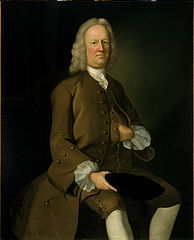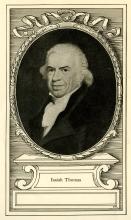Last month I
wrote about how the
Massachusetts Provincial Congress finally started commissioning infantry officers for its army (as opposed to its
militia) on 19 May 1775.
The first colonel to receive a commission was
Samuel Gerrish (c. 1729–1795) of
Newbury. I thought it would be interesting to look at what happened to him.
First of all, according to historian Richard Frothingham, Gerrish’s regiment wasn’t as complete as the congress had been led to believe; “there were difficulties in relation to six of the companies, which were investigated June 2.” Five of the companies originally listed under Gerrish’s name asked to serve under another Newbury colonel,
Moses Little. It took another twenty days before eight companies were fully commissioned under Gerrish.
During that spring the regiment was spread out along the north side of Boston harbor with three companies at
Chelsea, three in east
Cambridge, and two at Sewall’s Point, the finger of
Brookline land in front of the Charles and Muddy Rivers. On 16 June the officers of the regiment met at Chelsea and assigned jobs:
Loammi Baldwin to be lieutenant-colonel, Richard Dodge major, Christian Febiger adjutant, and so on. This was the New England way, electing from below rather than the colonel appointing from above.
One day after that meeting, of course, came the Battle of
Bunker Hill. In 1870 the Quincy family presented to the
Massachusetts Historical Society one sheet of what had been a two-page letter describing the fight. Whoever wrote that account took particular notice of Col. Gerrish’s behavior, referring to him by his rank from the
French &
Indian War:
Major Gerrish was ordered also to Charlestown with a reinforcement, but he no sooner came in sight of the enemy than a tremor seiz’d him & he began to bellow, “Retreat! retreat! or you’l all be cutt off!” which so confus’d & scar’d our men, that they retreated most precipitately, & our soldiery now sware vengeance against him & determine not to be under his commd.
The historian Samuel Swett later wrote that Gerrish “was unwieldy from excessive corpulence”; on reaching Bunker’s Hill above the fighting, “he declared that he was completely exhausted, and lay prostrate on the ground.” Col.
Israel Putnam roared at all the men stalled on that hill, hitting some with his sword, but they refused to go farther down and eventually retreated.
There was plenty of blame to go around after that battle. Other Massachusetts officers hadn’t even taken their troops onto the peninsula as Gerrish had. Swett wrote, “A complaint was lodged against him with [Gen.
Artemas] Ward immediately after the battle, who refused to notice it on account of the unorganized state of the army.”
Not that Col. Gerrish was helping alleviate that disorganization. On 7 July the new commander-in-chief’s secretary,
Joseph Reed,
wrote to him to ask a second time for a return of all the men in the regiment. “The Express [to the
Continental Congress] has been detain’d some time thro’ this Inattention,” Reed chided, “The Forces raised in
Connecticut,
New Hampshire &
Rhode Island having sent in their Returns very complete.”
Gerrish finally reported having 258 men in his regiment. Even after that, there were administrative problems. In August eight officers at Sewall’s Point
wrote to headquarters to complain that most of them had “been here in actual Service, since the Beginning of the Campaign, and been to a vast Deal of Expense, and not receiv’d one farthing of our pay.”
In early August, British floating
batteries made some attacks on American positions near the water. One fired on Sewall’s Point. Instead of shooting back at that boat, Gerrish told his men to put out any lights and hunker down behind their
fortifications. He was reported to have said, “the rascals can do us no harm, and it would be a mere waste of
powder, to fire at them with our 4 pounders.” Technically, Gerrish might have been right. The British shots caused no casualties. But the colonel had used up any benefit of the doubt about his behavior in battle.
TOMORROW: Washington weighs in.





.JPG/320px-Wright's_Tavern_(Concord%2C_MA).JPG)







